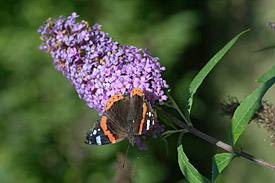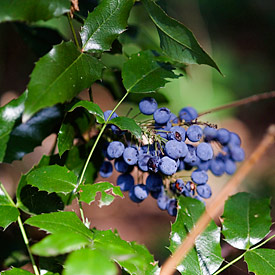Press release from May 27th, 2008
When the blue butterfly bush blossoms
Why invasive species have an advantage over established native ones.
Halle/Saale. Invasive plant species can flourish better in their new homes than in their place of origin. The reasons for this can be genetic changes or the lack of herbivores such as insects that first have to adapt to the newcomers. These are the conclusions of researchers from the Helmholtz Centre for Environmental Research (UFZ) from their research on Buddleia or the Butterfly bush (Buddleja davidii) and Oregon grape (Mahonia aquifolium). Due to this, invasive plant species would have an advantage over other native plant species and could therefore pose a threat to the ecological balance, as researchers have written in the scientific journal Diversity and Distributions.

Buddleia was introduced to Europe about one hundred years ago from China and has been cultivated since then.
Photo: Susan Ebeling/UFZ

The Oregon grape (Mahonia aquifolium) originates from the West of the USA.
Photo: Dr. Harald Auge/UFZ
It blossoms in blue, white or lilac in many gardens. Buddleia was introduced to Europe about one hundred years ago from China and has been cultivated since then. The ornamental shrub soon became popular, but not only in gardens. In post-war Germany the shrub was also able to spread on the rubble of bombed inner cities and in the meantime Buddleia grows wild in large parts of West and South West Germany. Only in the continental East of the country, propagation is hindered by winter frosts. Although the blossoms of the Buddleia are aesthetically pleasing and provide a food source for butterflies, this beauty has a dark side to it however. This immigrant also known as the butterfly bush can easily go to seed and form dense populations. Thus it has the potential to displace native species and becomes a safety risk along railway embankments because it rampantly grows there. Switzerland, Spain and France are trying to combat Buddleia, while in the USA its propagation is being observed critically and in New Zealand Buddleia is causing economic problems because it suppresses native vegetation.
In order to improve knowledge about the mechanisms responsible for the spread of invasive species, UFZ researchers compared ten populations of Buddleia in Germany with ten populations in its original homeland, the south west Chinese province Yunnan. Although the climatic conditions are more favourable in China, the bushes were larger in Germany and produced more and heavier seeds. "From the plants in the Chinese homeland, 15 percent of the leaves had been eaten by insects. By comparison, in Germany only 0.5 percent", reports Susan Ebeling from the UFZ. "The intruder is not yet on the menu for our insects. Because there are no relatives of Buddleia in Central Europe, the insects need longer to adapt." The two Asian insect species that were used in an attempt to control the bushes in New Zealand, are not yet present in Europe.
The situation is different with another species that researchers investigated more closely. The Oregon grape (Mahonia aquifolium) originates from the West of the USA. In Oregon, the evergreen bush with its salient yellow blooms is even the official plant of the US Federal State and is therefore also known as "Oregon grape". In Europe the Oregon grape has a similar relative: the European Barberry (Berberis vulgaris). Native insects had millions of years time to adapt to the European Barberry and could now comparatively easily "switch" to the Oregon grape. The Oregon grape on the other hand could not develop any defence mechanisms against its herbivores.
Nevertheless, it prospers so well in Central Europe that the Swiss Commission for the preservation of wild plants requests owners of gardens to do without the cultivation of Oregon grape as a preventative measure: "Should one already have this species in one’s garden, one must absolutely prevent any further propagation, on the one hand by removing the infructescence, and on the other hand by constantly removing any young shoots." In spite of herbivores, the Oregon grape is able to flourish, cover forest floors completely and consequently become a problem. "Its success obviously lies in cultivation. Through selection and hybridization it came to a genetic change, enabling the Oregon grape to grow larger in Europe than in its American homeland", Dr. Harald Auge of the UFZ explains the research results. The biologist and his colleagues from Halle had collected seeds from Oregon grape plants in the USA, Canada, Germany and the Czech Republic and had grown the plants under controlled conditions in a greenhouse.
Ornamental shrubs and cultivated plants constitute a majority of the alien plant species that have become a problem
and are therefore referred to as biological invaders by specialists. Biological invasions caused by humans are one of
the causes of the dramatic world-wide decrease in animal and plant species. According to a study conducted by the
Federal Environment Agency, the economic costs of 20 alien species investigated, amounted to approximately 167 million
Euros in the year 2002 in Germany. More recent figures are not yet available. In the near future, health care costs
caused by the highly allergenic Ragweed are to be investigated by the UFZ and financed by the Federal Ministry of
Research.
Tilo Arnhold
You can read more about biological invasions and other issues concerning biodiversity in a special edition of the UFZ newsletter for the 9th Meeting of the Conference of the Parties to the Convention on Biological Diversity (COP9), that will take place from 19 to 30 May in Bonn.
Publications:
Ebeling, S. K., Hensen, I., Auge, H. (2008):
The invasive shrub Buddleja davidii performs better in its introduced range
Diversity Distrib. 14 (2), 225-233
www.blackwell-synergy.com/doi/pdf/10.1111/j.1472-4642.2007.00422.x
Ross, C. A., Auge, H. (2008):
Invasive Mahonia plants outgrow their native relatives.
Plant Ecology (online first): DOI 10.1007/s11258-008-9408-z
www.springerlink.com/content/j7q5304562j54674/
Ross, C. A., Faust, D., Auge, H. (2008):
Mahonia invasions in different habitats: local adaptation or general-purpose genotypes? Biological Invasions (online first) DOI 10.1007/s10530-008-9261-y
www.springerlink.com/content/y7002j2414271347
Further information:
Helmholtz Centre for Environmental Research (UFZ)
Dr. Harald Auge
phone +49 345 558 5309
Dr. Harald Auge
und
Susan Ebeling
phone +49 345 558 5308
Susan Ebeling
or
Helmholtz Centre for Environmental Research
Presse office
Tilo Arnhold / Doris Böhme
Phone +49 341 235 2278
presse@ufz.de
Further links
Oregon grape (Mahonia aquifolium):
www.floraweb.de/pflanzenarten/artenhome.xsql?suchnr=3576&
www.cps-skew.ch/deutsch/inva_budd_dav_d.pdf
Butterfly bush (Buddleja davidii):
www.floraweb.de/neoflora/handbuch/buddlejadavidii.html
www.cps-skew.ch/deutsch/inva_maho_aqu_d.pdf
Biological control of B. davidiii in New Zealand:
www.ermanz.govt.nz/news-events/focus/biocontrol-agents.html
www.nzpps.org/journal/55/nzpp55_433.pdf
www.nzpps.org/journal/60/nzpp60_320.pdf
The ninth meeting of the Conference of the Parties (COP 9)
www.cbd.int/cop9
www.bmu.de/naturschutz_biologische_vielfalt/un-konferenz_2008
At the Helmholtz Centre for Environmental Research (UFZ) scientists research the causes and consequences of far-reaching environmental changes. They study water resources, biological diversity, the consequences of climate change and adaptation possibilities, environmental and biotechnologies, bio energy, the behaviour of chemicals in the environment and their effect on health, as well as modelling and social science issues. Their guiding research principle is supporting the sustainable use of natural resources and helping to secure these basic requirements of life over the long term under the influence of global change. The UFZ employs 900 people at its sites in Leipzig, Halle and Magdeburg. It is funded by the German government and by the states of Saxony and Saxony-Anhalt.
The Helmholtz Association helps solve major, pressing challenges facing society, science and the economy with top scientific achievements in six research areas: Energy, Earth and Environment, Health, Key Technologies, Structure of Matter, Transport and Space. With 25,700 employees in 15 research centres and an annual budget of around EUR 2.3 billion, the Helmholtz Association is Germany’s largest scientific organisation. Its work follows in the tradition of the great natural scientist Hermann von Helmholtz (1821-1894).
